CARunderscore
Structural
This doesn't have anything to do with a project of mine. Rather, it involves a potential public safety issue that I intend to bring to the local building inspection or public health/safety office. However, it's the weekend, and I'd also like some input from people who are experienced with masonry to help ground myself in terms of how concerned I should be.
There is an office building at the end of my street, located on a fairly steep hill. The east side of the building is the front and uphill side, facing the main road. It overlooks a small plaza bounded by what appears to be a retaining wall on the north side. On the north side is a steep street with a public sidewalk tight against the building, on the south side is a parking lot, and on the west side is my street, also with a public sidewalk. The exterior of the [steel-framed?] building is clad in a brick veneer, and the retaining wall matches it. I now suspect the "retaining wall" is actually the exterior wall of an enclosed parking garage, but I will refer to it as a retaining wall for simplicity.
About a month ago, I noticed two large vertical full-depth cracks at the corner of the "retaining wall": one behind the facade wythe facing the sidewalk, and a shorter one at the interface with the front of the building (it terminates at a door lintel). The outer wythe bulges out slightly at the widest point of the crack, near mid-height of the wall above grade. I measured the crack and there hasn't been any measurable change since.
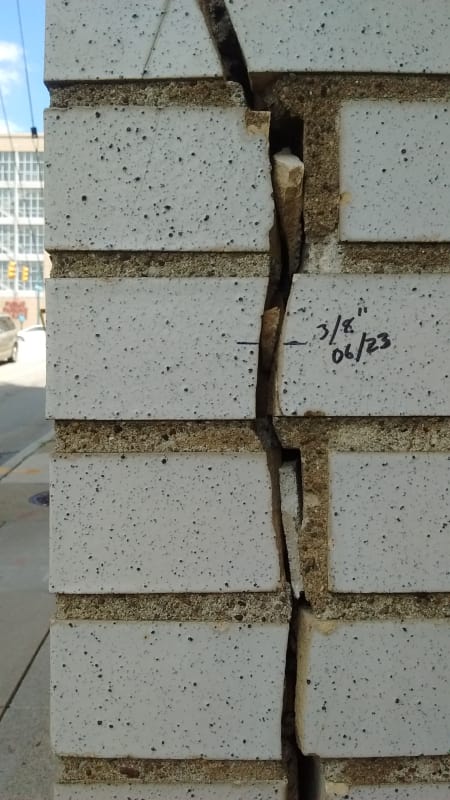
I have, however, noticed more cracks on the west (downhill) side of the building, as well as some out-of-plumbness in the west wall.
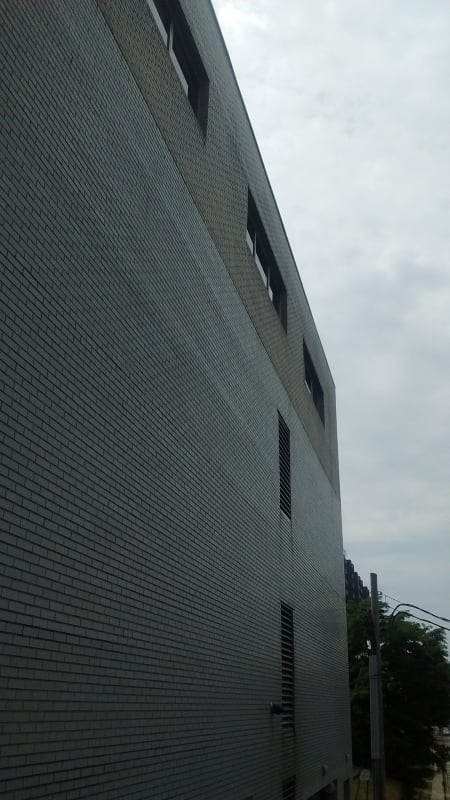
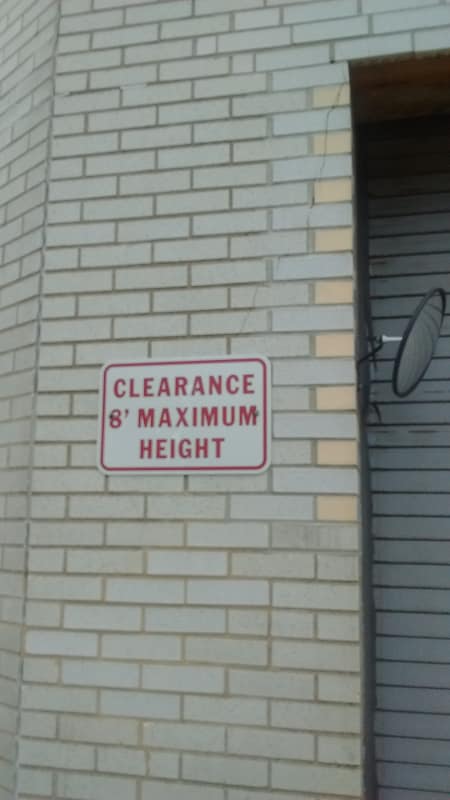
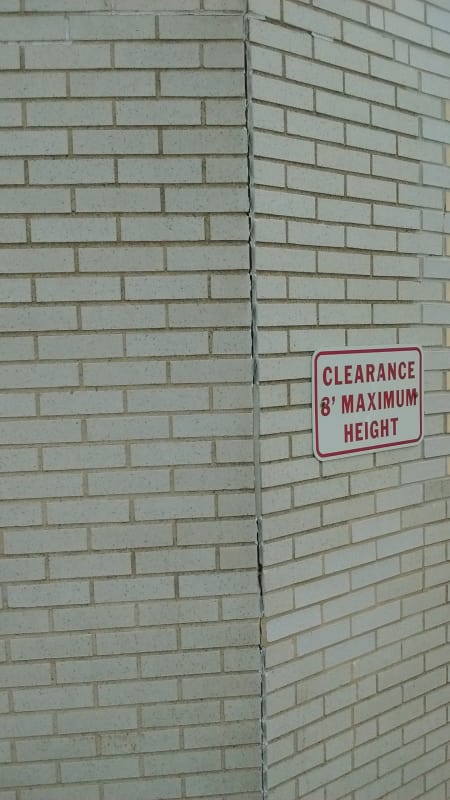
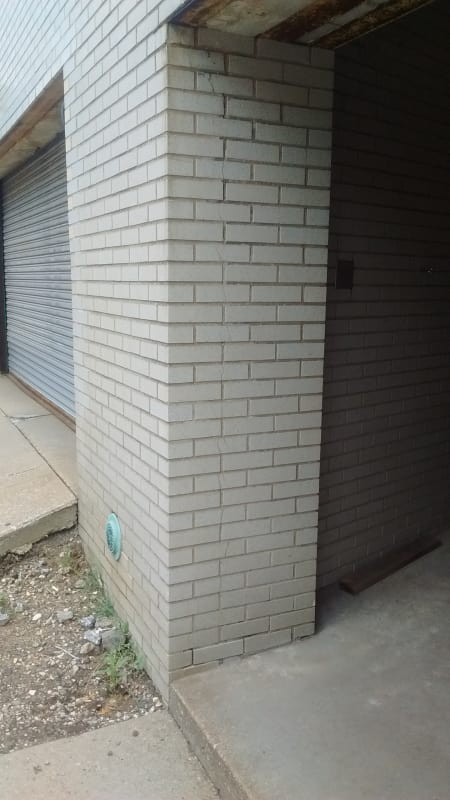
I didn't actually see the ripples near the upper louver until I uploaded the photos from my phone. What I was trying to capture in the picture was the wall seeming to bow out between the window openings. However, upon looking at the building from the south side, it appears that the west wall is plumb for most of its height, and that the top story [of the parking garage?] leans inward a bit, with an inflection point near the middle of the story. Note the evidence of various repairs.
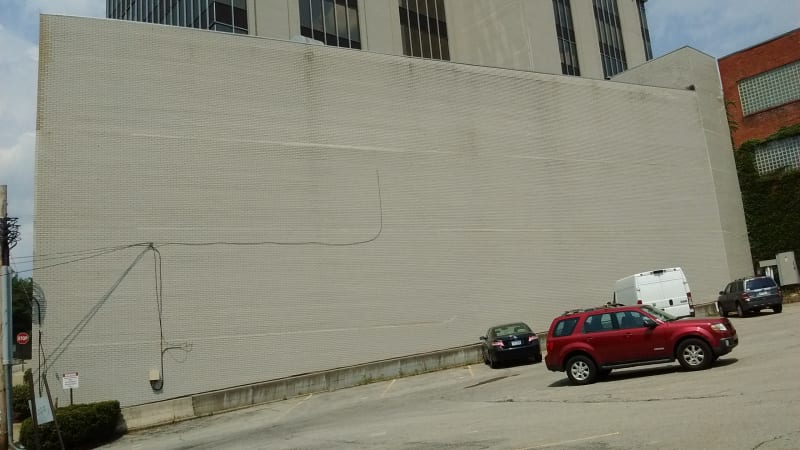
I've lived on this street for over a year and walk on this sidewalk almost every day. I've never noticed any significant cracks before last month, and I think that both they and the minor repairs seen in some of the photographs are new. But, also because I've lived here for awhile and am used to the scenery, I could be wrong. I have only a vague idea of what this building looks like on the inside and was unable to even find readily available information about when it was constructed. When the only cracks I noticed were those in the "retaining wall," I was content to just monitor them and only contact the authorities if I noted worrisome change, but now I am more concerned about masonry falling onto the sidewalk.
I don't really have a good sense of how much cracking/deformation a brick wall call tolerate before it becomes dangerous, especially not with these long, straight cracks that go through the brick. Any thoughts on what is going on here? Also, any advice on how to approach the local government about this? I figure there's a good chance that they're already aware of the issue, but maybe not.
Thanks,
CAR_
There is an office building at the end of my street, located on a fairly steep hill. The east side of the building is the front and uphill side, facing the main road. It overlooks a small plaza bounded by what appears to be a retaining wall on the north side. On the north side is a steep street with a public sidewalk tight against the building, on the south side is a parking lot, and on the west side is my street, also with a public sidewalk. The exterior of the [steel-framed?] building is clad in a brick veneer, and the retaining wall matches it. I now suspect the "retaining wall" is actually the exterior wall of an enclosed parking garage, but I will refer to it as a retaining wall for simplicity.
About a month ago, I noticed two large vertical full-depth cracks at the corner of the "retaining wall": one behind the facade wythe facing the sidewalk, and a shorter one at the interface with the front of the building (it terminates at a door lintel). The outer wythe bulges out slightly at the widest point of the crack, near mid-height of the wall above grade. I measured the crack and there hasn't been any measurable change since.

I have, however, noticed more cracks on the west (downhill) side of the building, as well as some out-of-plumbness in the west wall.




I didn't actually see the ripples near the upper louver until I uploaded the photos from my phone. What I was trying to capture in the picture was the wall seeming to bow out between the window openings. However, upon looking at the building from the south side, it appears that the west wall is plumb for most of its height, and that the top story [of the parking garage?] leans inward a bit, with an inflection point near the middle of the story. Note the evidence of various repairs.

I've lived on this street for over a year and walk on this sidewalk almost every day. I've never noticed any significant cracks before last month, and I think that both they and the minor repairs seen in some of the photographs are new. But, also because I've lived here for awhile and am used to the scenery, I could be wrong. I have only a vague idea of what this building looks like on the inside and was unable to even find readily available information about when it was constructed. When the only cracks I noticed were those in the "retaining wall," I was content to just monitor them and only contact the authorities if I noted worrisome change, but now I am more concerned about masonry falling onto the sidewalk.
I don't really have a good sense of how much cracking/deformation a brick wall call tolerate before it becomes dangerous, especially not with these long, straight cracks that go through the brick. Any thoughts on what is going on here? Also, any advice on how to approach the local government about this? I figure there's a good chance that they're already aware of the issue, but maybe not.
Thanks,
CAR_
